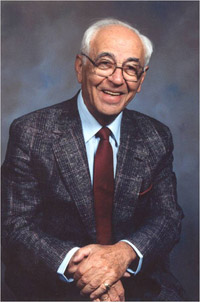 El Paso Holocaust Museum and Study Center had its very humble beginnings in 1984 when Holocaust survivor Henry Kellen decided it was time to tell his story and to educate the community about the horrors of the Holocaust. Until then, Mr. Kellen had not spoken publicly about his experiences—the result of a promise he and his first wife, Julia Kellen, had made to each other after arriving in the United States. However, a surge of Holocaust denial in the mainstream media during the 1980s convinced Mr. Kellen he could not be silent any more.
El Paso Holocaust Museum and Study Center had its very humble beginnings in 1984 when Holocaust survivor Henry Kellen decided it was time to tell his story and to educate the community about the horrors of the Holocaust. Until then, Mr. Kellen had not spoken publicly about his experiences—the result of a promise he and his first wife, Julia Kellen, had made to each other after arriving in the United States. However, a surge of Holocaust denial in the mainstream media during the 1980s convinced Mr. Kellen he could not be silent any more.
In 1984, Mr. Kellen borrowed space in a small corner of the Jewish Community Center on El Paso’s West Side. With a few books and a handful of personal items, he began telling his story. Word quickly spread about this Holocaust display and, before long, schools and interested people were making appointments to hear from Mr. Kellen. The space was so small that groups sat closely on the floor just to listen.
The community rallied behind Mr. Kellen’s desire to teach the Holocaust. Louis and Miriam Rosenbaum donated $250,000 so that a full-fledged museum could be built. By 1994, that museum, appropriately named the El Paso Holocaust Museum and Study Center, opened its doors next to the Jewish Community Center.
EPHM thrived in its new location and each year hosted thousands of visitors and hundreds of school tours. Sadly, an electrical fire in October, 2001, destroyed the original Museum. A devastated Henry Kellen rummaged through the charred remains and wondered if that was the end of his vision. Almost immediately after the fire, the Museum’s Board of Directors vowed to rebuild and work quickly began on a Capital Campaign to raise the money needed for a new Museum.
The community came through and $2.5 million was raised for the new Museum. It is worth noting that the majority of the money was raised in El Paso.
Meanwhile, the Museum did not stop operating. A dedicated staff continued to teach the lessons of the Holocaust—first through visits to schools and organizations and later through a temporary gallery space that was donated to the Museum until the new was completed. The Museum also introduced Education Trunks, complete with classroom sets of books and teaching materials, so that educators could continue to teach the Holocaust to their students.
 Seven years after that electrical fire, the El Paso Holocaust Museum and Study Center reopened its doors to the public in January, 2008, and is part of El Paso’s Museum District Downtown. The Museum features 4,000 square feet of permanent exhibit space and an additional 1,000 square feet of traveling exhibit space.
Seven years after that electrical fire, the El Paso Holocaust Museum and Study Center reopened its doors to the public in January, 2008, and is part of El Paso’s Museum District Downtown. The Museum features 4,000 square feet of permanent exhibit space and an additional 1,000 square feet of traveling exhibit space.
EPHM, which celebrated its 30th Anniversary in 2014, was the first Holocaust museum to be established in Texas and is now currently one of only 13 free-standing Holocaust museums in the United States. EPHM is the only fully bilingual Holocaust museum in the United States.
Today, the Museum continues its mission of educating the public about the Nazi Holocaust so that similar acts will not be repeated. Additionally, the Museum honors the 11 million people who perished in the Holocaust as well as the brave souls who survived.
Each year, thousands of people visit the Museum. Visitors include students from the region’s many school districts, college students, residents from El Paso and the surrounding regions as well as out-of-town visitors from every corner of the world.
